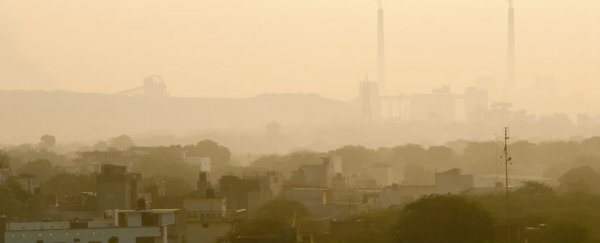The Indian government has declared a national emergency, as air pollution in its capital, New Delhi, has reached levels more than 16 times the safe limit.
Now, more than 1,800 schools have closed down in an effort to keep children indoors, and middle-class professionals and expats have started to migrate out of the city. Delhi's chief minister, Arvind Kejriwal even went so far as to call the city a "gas chamber".
"Pollution has increased to an extent that outdoors in Delhi are resembling a gas chamber," Kejriwal told a media conference over the weekend.
That might sound extreme, but the city has been sitting in the Air Quality Index 'red zone' for more than a week now, and things are actually getting worse.
When researchers measure air pollution, they typically take two types of particles into consideration: PM10 is particulate matter 10 micrometres (μm) or less in diameter, and PM2.5 is particulate matter 2.5 μm or less in diameter.
We're talking soot, smoke, and dust particles that can get caught up in your lungs and cause long-term health problems like asthma and chronic respiratory diseases - of which India has the highest rate in the world.
There's even some evidence to suggest that metallic particles in pollution from fuel burning could be causing Alzheimer's disease.
Both types of pollution are measured by the average amount per cubic metre, and according to data from the System of Air Quality and Weather Forecasting and Research (SAFAR), New Delhi today saw PM10 hit 876 μm/m3, and PM2.5 hit 680 μm/m3.
To put that into perspective, safe limits for PM10 and PM2.5 are considered to be 100 μg/m3 and 60 μg/m3 respectively.
But that's the upper limit - even those levels can give a person serious health problems.
According to the US Environmental Protection Agency, PM2.5 starts to become a health problem when there is more than 35.5 μg/m3, and the World Health Organisation (WHO) recommends that PM2.5 shouldn't even exceed 10 μg/m3.
While New Delhi was already considered one of the most polluted cities in the world, things haven't always been this bad.
In fact, back in March, when WHO data put New Delhi at the top of the planet's 10 most polluted cities, its PM2.5 was at 153 μg/m3 - still considered "very unhealthy", but nowhere near the current rate.
Check out the difference a few months can make:
Kalkaji, as viewed from 15th floor of a building in Nehru Place, New Delhi.
— Rajesh Advani (@advanirajesh) November 3, 2016
Pic 1: Aug 22, ’16
Pic 2: Today
Around same time. #Pollution pic.twitter.com/UfLeOwCf31
So what happened?
Kejriwal suggested that a "large scale" influx of smoke from the neighbouring regions of Punjab and Haryana has intensified the smog in New Delhi, telling the media, "[T]he biggest reason seems to be burning of stubble in agricultural fields in Haryana and Punjab in huge quantity."
Officials have also blamed the hundreds or thousands of fireworks that have been let off all over New Delhi for beginning of the Diwali festival, which kicks off every year at the end of October.
As Michael Safi reports for The Guardian, these fireworks usually leave a haze that lasts for two or three days, but this year, the smog has persisted for almost a week.
"Fireworks during Diwali marginally added to the pollution. But other things inside Delhi did not drastically change. So the smog is mainly due to smoke from farm fires," said Kejriwal.
The people are now protesting to try and force the local government to take control of the situation.
Measures so far include restricting vehicles on the city's roads - with mixed results - and pitching more environmentally friendly processes to farmers.
"On November 6, [the city] imposed a temporary ban on construction and demolition of buildings and the use of diesel-powered electricity generators," Quartz reports. "It also plans to vacuum clean the city's streets and has begun sprinkling water to settle the dust."
Only time will tell if any of these measures will have an effect, but hopefully winds will set in soon to at least shift some of the smog.
As the city moves out of winter, things should ease up slightly too, with researchers finding that the low wind and increased home heating of winter typically makes air pollution in New Delhi worse.
If there's any hope, it's that Beijing was in the red back in December, with its PM2.5 levels as high as 634 μg/m3, but they've since dropped to a maximum of 263 μg/m3 - which is still not great, but it's certainly better.
Hopefully a solution will be found in New Delhi - and fast - so kids can go back to school, and residents can come home.
